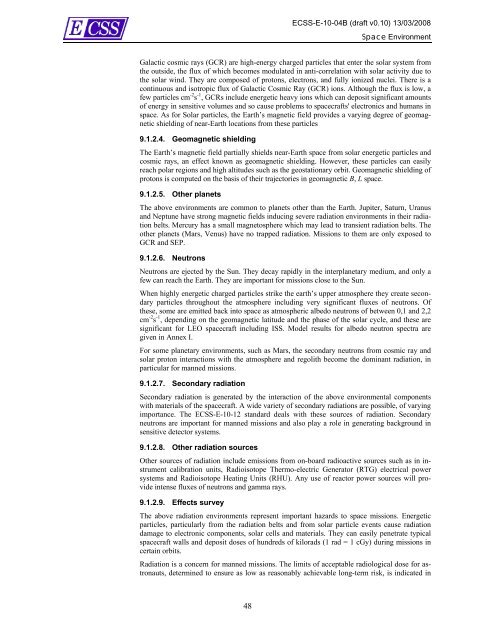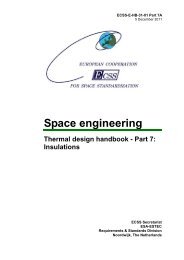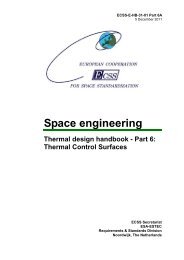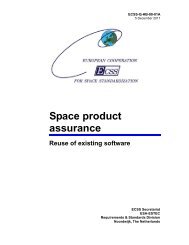ECSS E 10-04 v0.10 - European Cooperation on Space Standardization ...
ECSS E 10-04 v0.10 - European Cooperation on Space Standardization ...
ECSS E 10-04 v0.10 - European Cooperation on Space Standardization ...
Create successful ePaper yourself
Turn your PDF publications into a flip-book with our unique Google optimized e-Paper software.
48<br />
<str<strong>on</strong>g>ECSS</str<strong>on</strong>g>-E-<str<strong>on</strong>g>10</str<strong>on</strong>g>-<str<strong>on</strong>g>04</str<strong>on</strong>g>B (draft v0.<str<strong>on</strong>g>10</str<strong>on</strong>g>) 13/03/2008<br />
<strong>Space</strong> Envir<strong>on</strong>ment<br />
Galactic cosmic rays (GCR) are high-energy charged particles that enter the solar system from<br />
the outside, the flux of which becomes modulated in anti-correlati<strong>on</strong> with solar activity due to<br />
the solar wind. They are composed of prot<strong>on</strong>s, electr<strong>on</strong>s, and fully i<strong>on</strong>ized nuclei. There is a<br />
c<strong>on</strong>tinuous and isotropic flux of Galactic Cosmic Ray (GCR) i<strong>on</strong>s. Although the flux is low, a<br />
few particles cm -2 s -1 , GCRs include energetic heavy i<strong>on</strong>s which can deposit significant amounts<br />
of energy in sensitive volumes and so cause problems to spacecrafts' electr<strong>on</strong>ics and humans in<br />
space. As for Solar particles, the Earth’s magnetic field provides a varying degree of geomagnetic<br />
shielding of near-Earth locati<strong>on</strong>s from these particles<br />
9.1.2.4. Geomagnetic shielding<br />
The Earth’s magnetic field partially shields near-Earth space from solar energetic particles and<br />
cosmic rays, an effect known as geomagnetic shielding. However, these particles can easily<br />
reach polar regi<strong>on</strong>s and high altitudes such as the geostati<strong>on</strong>ary orbit. Geomagnetic shielding of<br />
prot<strong>on</strong>s is computed <strong>on</strong> the basis of their trajectories in geomagnetic B, L space.<br />
9.1.2.5. Other planets<br />
The above envir<strong>on</strong>ments are comm<strong>on</strong> to planets other than the Earth. Jupiter, Saturn, Uranus<br />
and Neptune have str<strong>on</strong>g magnetic fields inducing severe radiati<strong>on</strong> envir<strong>on</strong>ments in their radiati<strong>on</strong><br />
belts. Mercury has a small magnetosphere which may lead to transient radiati<strong>on</strong> belts. The<br />
other planets (Mars, Venus) have no trapped radiati<strong>on</strong>. Missi<strong>on</strong>s to them are <strong>on</strong>ly exposed to<br />
GCR and SEP.<br />
9.1.2.6. Neutr<strong>on</strong>s<br />
Neutr<strong>on</strong>s are ejected by the Sun. They decay rapidly in the interplanetary medium, and <strong>on</strong>ly a<br />
few can reach the Earth. They are important for missi<strong>on</strong>s close to the Sun.<br />
When highly energetic charged particles strike the earth’s upper atmosphere they create sec<strong>on</strong>dary<br />
particles throughout the atmosphere including very significant fluxes of neutr<strong>on</strong>s. Of<br />
these, some are emitted back into space as atmospheric albedo neutr<strong>on</strong>s of between 0,1 and 2,2<br />
cm -2 s -1 , depending <strong>on</strong> the geomagnetic latitude and the phase of the solar cycle, and these are<br />
significant for LEO spacecraft including ISS. Model results for albedo neutr<strong>on</strong> spectra are<br />
given in Annex I.<br />
For some planetary envir<strong>on</strong>ments, such as Mars, the sec<strong>on</strong>dary neutr<strong>on</strong>s from cosmic ray and<br />
solar prot<strong>on</strong> interacti<strong>on</strong>s with the atmosphere and regolith become the dominant radiati<strong>on</strong>, in<br />
particular for manned missi<strong>on</strong>s.<br />
9.1.2.7. Sec<strong>on</strong>dary radiati<strong>on</strong><br />
Sec<strong>on</strong>dary radiati<strong>on</strong> is generated by the interacti<strong>on</strong> of the above envir<strong>on</strong>mental comp<strong>on</strong>ents<br />
with materials of the spacecraft. A wide variety of sec<strong>on</strong>dary radiati<strong>on</strong>s are possible, of varying<br />
importance. The <str<strong>on</strong>g>ECSS</str<strong>on</strong>g>-E-<str<strong>on</strong>g>10</str<strong>on</strong>g>-12 standard deals with these sources of radiati<strong>on</strong>. Sec<strong>on</strong>dary<br />
neutr<strong>on</strong>s are important for manned missi<strong>on</strong>s and also play a role in generating background in<br />
sensitive detector systems.<br />
9.1.2.8. Other radiati<strong>on</strong> sources<br />
Other sources of radiati<strong>on</strong> include emissi<strong>on</strong>s from <strong>on</strong>-board radioactive sources such as in instrument<br />
calibrati<strong>on</strong> units, Radioisotope Thermo-electric Generator (RTG) electrical power<br />
systems and Radioisotope Heating Units (RHU). Any use of reactor power sources will provide<br />
intense fluxes of neutr<strong>on</strong>s and gamma rays.<br />
9.1.2.9. Effects survey<br />
The above radiati<strong>on</strong> envir<strong>on</strong>ments represent important hazards to space missi<strong>on</strong>s. Energetic<br />
particles, particularly from the radiati<strong>on</strong> belts and from solar particle events cause radiati<strong>on</strong><br />
damage to electr<strong>on</strong>ic comp<strong>on</strong>ents, solar cells and materials. They can easily penetrate typical<br />
spacecraft walls and deposit doses of hundreds of kilorads (1 rad = 1 cGy) during missi<strong>on</strong>s in<br />
certain orbits.<br />
Radiati<strong>on</strong> is a c<strong>on</strong>cern for manned missi<strong>on</strong>s. The limits of acceptable radiological dose for astr<strong>on</strong>auts,<br />
determined to ensure as low as reas<strong>on</strong>ably achievable l<strong>on</strong>g-term risk, is indicated in






